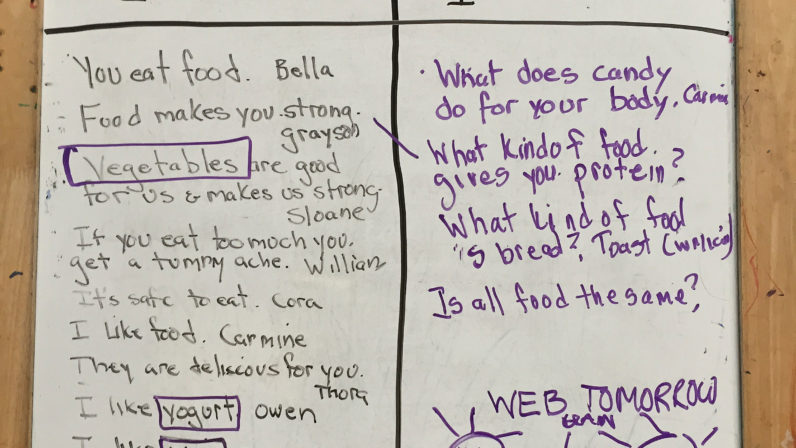Often a study begins with a question. “Where does hummus come from?” “What does candy do for your body?” “How can we turn into food detectives?” Questions like these are surfacing around the Seed as we prepare to embark on our annual school-wide nutrition study. We’ve had many successful studies in the past and expect this year’s to be equally engaging and informative. Since this year’s professional development work during teacher prep week was on the Project Approach (http://projectapproach.org), we are emphasizing staying true to the three phases of project-based learning. Phase one includes:
- agreement on a topic
- recording what children already know
- revisiting past experiences with topic
- formulating questions/making predictions
- deciding where information can be found
I spent time early this week interviewing each teacher to check in on phase one. The results were delightful, particularly the way in which teachers at each age level creatively collected the children’s interests in the topic. Toddler 1s teachers pulled out kid-size shopping bags and noticed that they liked to “shop” for plastic food and other items. They provided children with snacks that require use of spoons and forks and observed the children’s curiosity about the utensils. To involve families, they’re planning to ask parents to bring in a toddler-friendly utensil from home that will incorporate their family study with the nutrition study. Early 3s teachers have been reading and rereading one of their students’ favorite stories, Big Hungry Bear and the Strawberry. Since their interest is so strong for this story, they’ve decided to begin their nutrition study about what bears eat, and then transition humans. They’ll also look at all the colors of foods humans eat.
For our preschool classes, much of the beginning conversations were initiated by taking surveys of children’s lunches. Some teachers started by writing down the children’s food quotes, noticing that words like “protein,” “vegetables,” and “delicious” are already in some of their students’ vocabularies. Their plan is to continue using surveys, picture books, and direct exploration of foods to see what direction their study will follow. These classes, as well as the kindergarten, will be reaching out to parents to deepen the connection between home and school regarding food.
A common phenomenon in the two older classes was a specific interest each teacher was hoping to follow. However, those ideas were slightly derailed as soon as student interests were known. First and second graders, especially those who had been a part of Magic Body World (https://www.awakeningseedschool.org/2016/05/magic-body-world/) in PreK two years ago, were adamant about a study of the human digestive system. When I last checked in with them, they were considering changing the playground into a mock digestive system. The 3rd/4th grade teacher’s interest in a study of sugar was quickly revised by her students’ excitement about being food detectives as they studied nutritional labels.
In the next two weeks our annual nutrition study will take many turns, guided by observant teachers and their students’ ideas. As we embark on our foodie adventure, we hope you’ll join in. Check out the seedfood website (seedfood.awakeningseedschool.org), let us know if you’d like to be a guest blogger on the site, and ask lots of questions. If you have a special passion around food, let us know. Early experiences with food make a lasting impression on our children. Our intention is to ensure that those impressions become the foundation of a long and healthy life for each of our Awakening Seeds.

